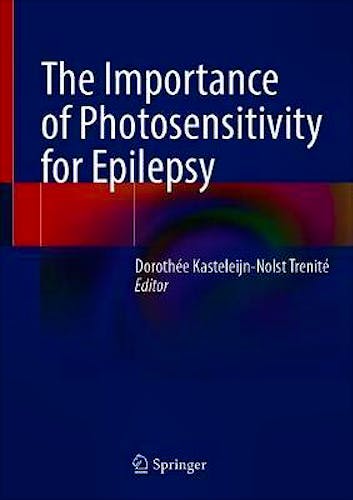

No hay productos en el carrito



The Importance of Photosensitivity for Epilepsy
Kasteleijn-Nolst, D.
1ª Edición Enero 2021
Inglés
Tapa dura
462 pags
1242 gr
18 x 26 x 3 cm
ISBN 9783319050799
Editorial SPRINGER
LIBRO IMPRESO
-5%
103,99 €98,79 €IVA incluido
99,99 €94,99 €IVA no incluido
Recíbelo en un plazo de
2 - 3 semanas
LIBRO ELECTRÓNICO
-5%
93,59 €88,91 €IVA incluido
89,99 €85,49 €IVA no incluido
Acceso On Line
Inmediato
Part I. Has Photosensitivity changed over the years?.- Epidemiology.- Provocative factors.- History and positioning within reflex epilepsies.- PartT II. Does Photosensitivity Matter; Clinical Relevance?.- Correlation EEG and clinic.- Prognosis.- Special syndromes.- Does Photosensitivity exist in focal epilepsy?.- Existence of Photosensitivity in various disease states. Headache, Brain tumor, Depression and Mania, Pain, Alzheimer, Autism, Posttraumatic conditions.- What can we learn from a photosensitive patient?.- PART III. Abnormal Electroencephalographic Response to Photic Stimulation.- How to interpret Photoparoxysmal EEG results? Sleep, NSD etc.- The basics: what constitutes a Photoparoxysmal Response? FMRI, MEG,TMS and PET-studies.- Is Photosensitivity a threshold phenomenon? Gamma-band etc.- What can we learn from photosensitivity in animals? Baboon, dog, cat, rat, mouse, zebrafish.- Is there a difference between kindled and genetically prone photosensitive animals and how relates that to humans?.- Part IV. The PPR: influence of age, sex and ethnicity.- Familiar and genetic differences in outcome.- Ethnical differences.- Gender differences? Hormonal influences.- Age differences? Dravet versus IGE etc.- Part V. How to Approach the Patient with Photosensitivity.- Optimizing the patient's history: a modern approach to age-old life interviews.- Safety of EEG methodology in Photosensitivity.- Maximizing EEG methodology in Photosensitivity: do's and don'ts.- Identification of geographic sites studying photosensitivity.- PART VI. Treatment and Management of Photosensitivity.- Treatment and prevention: when?.- Treatment and prevention: how?.- Seizure control to prevent anxiety for new seizures- psychosocial impact.- Impact of photosensitivity on psychology: are JME with and without PPR different, self-induction etc.- Use of Photosensitivity as trait: a biomarker for genetics.- Creative use of Photosensitivity: studies exploring new AED and other drug development.- How to inform architects and videogame producers about possible risks of certain visual stimuli?.- What the patient and parents/caregivers need to know.- Photosensitivity within the classification systems: past, present and future.- Appendix.
This book offers a detailed account of all aspects of photosensitive epilepsy, including genetic testing, functional imaging (fMRI, MEG), pharmacological studies, animal studies, classification based on the occurrence of photoparoxysmal responses (PPRs) in different epilepsy syndromes, and the available prevention and treatment options. In addition, the comorbidity of and overlap between migraine and epilepsy are discussed. Informative case histories with EEG examples and a helpful glossary are included.
In epilepsy, the term photosensitivity is used both for epileptic seizures triggered by flashing or flickering light and for epileptiform discharges evoked by intermittent photic stimulation (IPS) during an EEG recording. Most patients with a clear history of visually induced seizures will show epileptiform EEG discharges during IPS (PPRs). As epileptiform discharges can be evoked in photosensitive patients at any time, without triggering seizures, they can be considered a useful surrogate marker of the necessity and efficacy of epilepsy treatment. This book will serve as an ideal guide to the subject for pediatricians, (pediatric) neurologists, epileptologists, (child) psychiatrists, clinical geneticists, neuropsychologists, neuropharmacologists, occupational therapists, and basic scientists.
Dorothee Kasteleijn-Nolst Trenite, MD, PhD, works in the Department of Medical Genetics, University Medical Center Utrecht, the Netherlands and the Child Neurology Division, Department of Pediatrics, Sapienza University of Rome, Italy. Her work in Utrecht aims to help unravel epilepsy genetics, while in Rome she was given a Marie Curie Chair position within the FP6 EU research program. Dr. Kasteleijn trained extensively in epilepsy at the Epilepsy Centre "Meer en Bosch- de Cruquiushoeve" (now known as SEIN) and in video-EEG and the combination of pharmacology and EEG studies. Dr. Kasteleijn has practiced both child and adult neurology. She has done research on various topics in epilepsy (driving, neuropsychology, and neuropharmacology), but above all has been known for her work on photosensitivity since the publication of her thesis on this topic in 1989. She enjoys international collaboration and has (co-)organized many workshops, founded a European Consortium on Photosensitivity Genetics, and stimulated the development of EU guidelines. She is the author of very many peer-reviewed articles and book chapters and is regularly invited as a keynote speaker all over the world. She is an editor and reviewer for many journals in the field of Neurology. She has had many international PhD and Master's students. One of her most consistent activities besides lecturing and publishing is raising awareness at the international level of the patient with epilepsy in general and photosensitive epilepsy in particular.
© 2026 Axón Librería S.L.
2.149.0